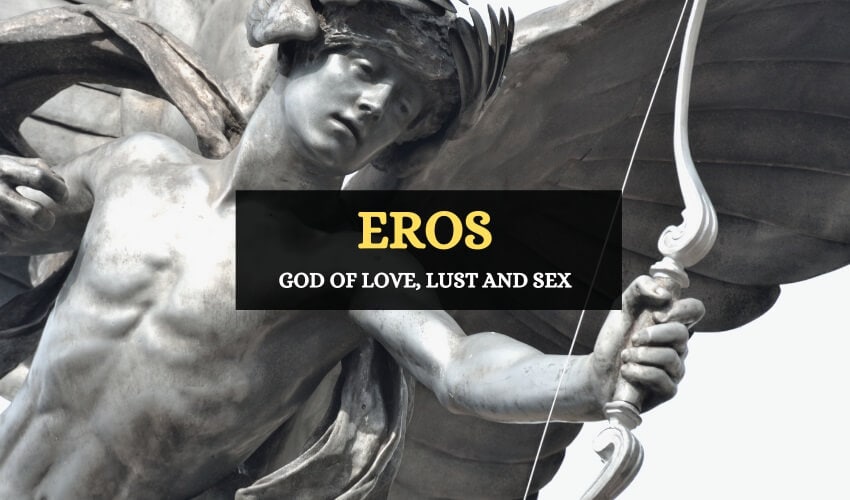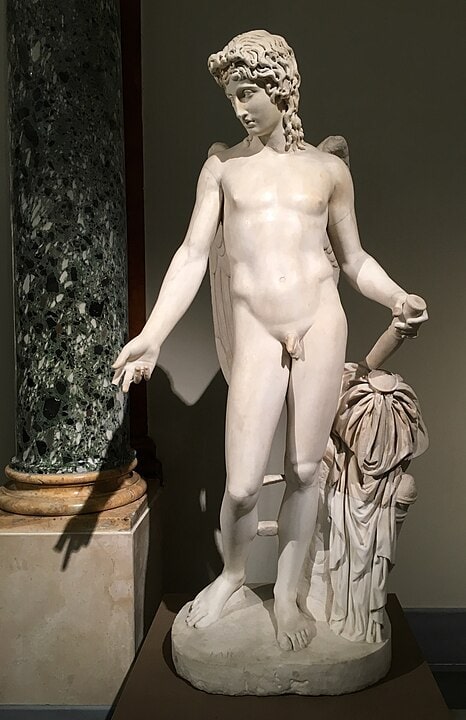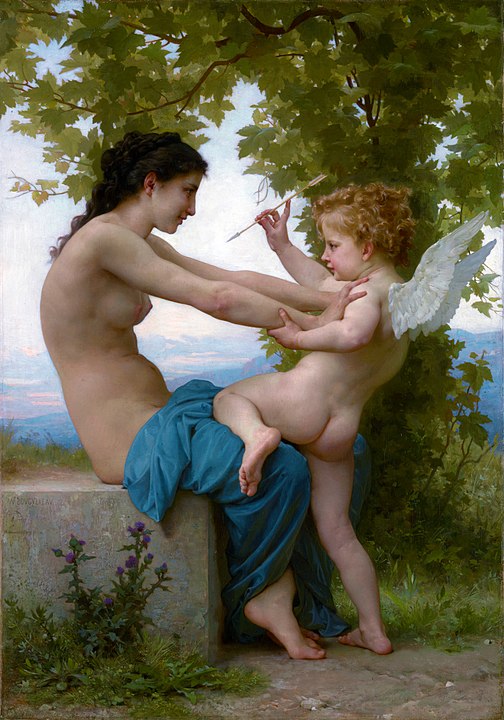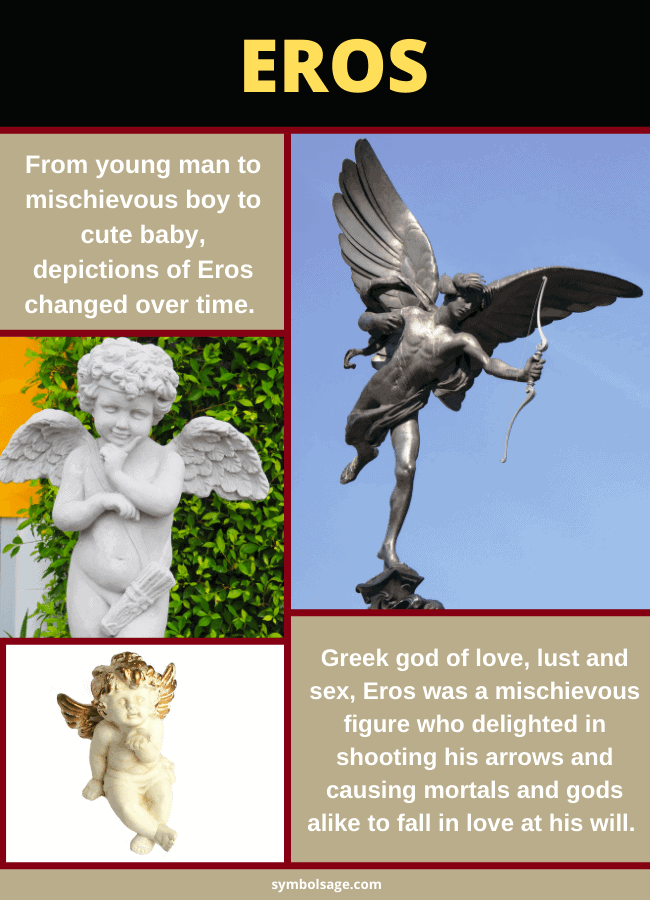
Table of Contents
In Greek mythology, nobody could escape the powers of the great Eros (Roman equivalent Cupid), the god of love, lust and sex. He could influence mortals and gods alike, making them fall in love and become crazed with passion. It is from Eros that we get the word erotic.
Eros’ depictions vary, from young man to eventual infant, but the underlying theme of Eros’ role remains the same – as the god of love, Eros enjoyed nothing more than to make people fall in love.
Origins of Eros

There are several accounts of the origins of Eros. He goes from being a primordial deity to one of Aphrodite’s children.
Eros as a Primordial Deity
In Hesiod’s Theogony, Eros is the primordial deity of love, who emerged at the dawn of creation, becoming one of the first gods to exist. He was not only the god of love but also the god of fertility and oversaw the creation of life in the universe. In these myths, Eros was the brother of Gaia, Uranus, and several other primordial deities. However, other accounts say that Eros emerged from an egg laid by Nyx, the goddess of the night.
Eros as One of the Erotes of Aphrodite and Ares
In other myths, Eros was one of the many sons of Aphrodite, the goddess of love, and Ares, the god of war. As the god of love, he was one of Aphrodite’s Erotes, a group of winged gods associated with love and sexuality, who made up Aphrodite’s entourage. The other Erotes were: Himeros (desire), Pothos (longing), and Anteros (mutual love). However, in later myths, the number of Erotes increased.
Depictions of Eros

Eros’ depictions show him as a winged young man of great beauty. Later on, he was portrayed as a mischievous boy, but these portrayals kept getting younger and younger until finally Eros became an infant. This is why there are several different versions of cupid – from handsome man to chubby and cheeky baby.
Eros was often portrayed carrying a lyre, and sometimes he would be seen with flutes, roses, torches or dolphins. However, his most famous symbol is the bow and quiver. With his arrows, Eros was able to cause undying passion and love in anybody he shot. He had two main types of arrows – golden arrows that caused a someone to fall in love with the first person they laid eyes on, and lead arrows that made a person immune to love and despise a person.
Eros’s Myths
Eros was famous for toying with the subjects of his arrows since nobody was immune to them. He took his shots randomly and made a rush of madness and frenzy invade people, heroes, and gods. His stories involved his reckless arrows and his enamored victims. Even though he was a god of love, he used his powers to cause mayhem among people with their passions.
Eros was a central part of the story of the hero Jason. Following Hera’s instructions, Eros made the princess Medea fall for the Greek hero to help him accomplish the quest of the Golden Fleece. Like with Jason, Eros used his powers on many heroes and mortals under the instructions of various gods.
1- Eros and Apollo
Apollo, who was a fantastic archer, mocked Eros for his small height, his weaknesses, and the purpose of his darts. Apollo boasted about how he aimed his shots at enemies and beasts, while Eros’ aimed his arrows at anybody.
The god of love would not take this disrespect and shot Apollo with one of his love arrows. Apollo immediately fell in love with the first person he saw, who happened to be the nymph Daphne. Eros then shot Daphne with a lead arrow, which made her immune to Apollo’s advances and so she rejected him.
2- Eros and Psyche
Psyche was once a mortal princess who was so beautiful that she made Aphrodite jealous with her countless suitors. For this, Aphrodite commanded Eros to make the princess fall in love with the ugliest man on earth. Eros himself was not immune to his own arrows, and while following Aphrodite’s command, he scratched himself with one of them.
Eros fell in love with Psyche and took her to a hidden place where he would visit her every day without revealing his true identity. Eros told the princess that she should never look at him directly, but under her jealous sister’s advice, Psyche did so. Eros felt betrayed by his wife and left, leaving the princess heartbroken.
Psyche looked for Eros everywhere, and eventually came to Aphrodite and asked her for assistance. The goddess gave her a series of impossible tasks to complete. After accomplishing all these tasks, which even included going to the underworld, Eros and Psyche were together once again. The two married and Psyche became the goddess of the soul.
Eros in Roman Tradition
In Roman Tradition, Eros became known as Cupid, and his stories would transcend into modern culture as the main deity of love. The depictions of the god as a young man were left aside, and he was widely portrayed as a winged infant still with his bow and love-inducing arrows. In Roman mythology, Eros has little initiative, and instead simply exists to follow his mother, Aphrodite, fulfilling her commands.

Modern Culture and St. Valentine’s Day
After the Greeks and the Romans, Eros remerged during the renaissance. He appears in many depictions, either alone or with Aphrodite.
In the 18th century, St. Valentine’s day was growing in popularity as an important holiday, and Eros, as the Greek god of love and desire, became the symbol of the celebration. He was depicted in cards, boxes, chocolates, and a variety of gifts and decorations related to the festivity.
Today’s Eros differs vastly from the way Eros acted in the Greek and Roman myths. The mischievous god who used his arrows to create mayhem and chaos with love and passion has little to do with the winged baby related to romantic love that we know nowadays.
Below is a list of the editor’s top picks featuring the statue of Eros.
Facts About Eros God
The sources offer conflicting information. In some accounts, Eros is a primordial deity born of Chaos, while in others, he’s the son of Aphrodite and Ares.
Eros consort is Psyche.
Eros had one child called Hedone (Voluptas in Roman mythology)
Eros is known as Cupid in Roman mythology.
Eros is the god of love, lust and sex.
In early depictions, Eros is portrayed as a beautiful young man, but over time, he is shown to be younger and younger, until he becomes an infant.
As the god of love, Eros became a symbol of the holiday which celebrated love.
In some versions, Eros is an Erote, one of the winged gods of love and sex and part of Aphrodite’s entourage.
In Brief
Eros’ role in Greek mythology connected him to several love stories and to the disruptions he caused with his arrows. Eros became a substantial part of western culture due to his representations in love festivities. He remains one of the most influential figures of Greek mythology, with a strong presence in modern culture.











